Documentary, directed by Thomas Grand, ZIDEOPROD 2009, 52 min. Sound track Wolof with French sub-titles. Produced with the support of the Spanish International Development Cooperation (AECID)
Review by Thomas Zadrozny
With "Kayar – a childhood caught in the nets", based on the life of artisanal fishermen in the third artisanal fishing port in Senegal, the French filmmaker Thomas Grand offers a fascinating as well as oppressive portrait of the dramas of this lively fishing town.
Kayar is situated 60 km north of the capital Dakar, next to a marine cañon, which provides habitat to a great diversity of marine species.
Particularly the bottom dwelling species are commercially very valuable. In season, also small pelagics get caught in large surround nets.
It also has rich farming ground for vegetable production thanks to available freshwater.
 Indeed, the name Kayar itself reflects these two sources of livelihood: it means being between the sea and the land.
Indeed, the name Kayar itself reflects these two sources of livelihood: it means being between the sea and the land.
Families from Saint Louis, Yoff and Rufisque were initially the principal settlers and have given Kayar its specific character. In 2002, town status was conferred to Kayar.
As fishing was very lucrative for a long time, gardening has been neglected. But over the last 10 years a creeping crisis in the fisheries has spelled increasing hardship for Kayar.
The causes can be sought in overfishing and the consequently diminishing resources.
In turn the overexploitation is driven by relentless expansion of all types of fishing, human demography, policies encouraging technological modernisation.
But at the same time, it is failing to regulate access to resources effectively.
The absence of no-take periods during reproduction times of key species and incursions of bottom trawlers, which destroy the habitats on the seafloor, to name but the most obvious, all contribute to resource overuse and eventually also economically less interesting returns on fishing effort.
This has also reduced the diversity of exploitable species.
Click here to see the beginning of the film on the Mundus maris channel.
The film describes the life and prospects of Adama, a boy turned fisherman.
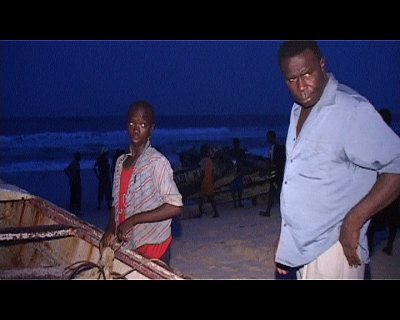 This film is only too real, showing hard evidence of the underlying causes and consequences of the mass exodus of young fishermen to Europe.
This film is only too real, showing hard evidence of the underlying causes and consequences of the mass exodus of young fishermen to Europe.
Exciting, visually beautiful, very mystical and yet both, practice-oriented and constantly philosophical, "Kayar – a childhood caught in the nets" raises certainly in the admirers of the film the beginning of their commitment to solving the social problems presented.
Thomas Grand makes us reflect, through the fate of a child confronted with the tradition of artisanal fisheries and the new doors that may be opened by school enrollment, the myriad problems many fishing villages now live through.
Issues such as access to education, health, vocational training, issues of parental responsibility, retraining and alternatives to fishing, are presented in a simple but real, clear and accurate manner and all that with the magical, but not at all picturesque, effect of life in Africa.
 This is the great success of the film: daring, reproducing in full the realities, depicting the complicated issues and hope - all these elements are masterfully blended around the life of a boy full of life and hope.
This is the great success of the film: daring, reproducing in full the realities, depicting the complicated issues and hope - all these elements are masterfully blended around the life of a boy full of life and hope.
By following the daily life of Adama, the film takes us along through several chapters of life in Kayar.
We see how men in the very height of their career, are tired of the hard life as fishermen, therefore send their children to do the work for them and bring home the increasingly modest gains of this work.
An important moment of the film is when one compares this to the choice of going to school in a village with only a very limited school enrollment capacity.
This is among the causes of having hardly any alternatives outside of fishing for boys and postharvest activities for girls.
 Kayar does not have a nursery school and a very limited capacity in primary school.
Kayar does not have a nursery school and a very limited capacity in primary school.
The film shows this harsh reality, where many children must return home after failing to find a place.
However, the efforts of the teaching team to tackle this problem are quite original since they organised two rotating parallel classes with the same resources.
With regard to secondary education, only some 500 young people can be accommodated at the College mid-level education (CEM) of Kayar.
Young people wanting to go forward with their education are then forced to make very long trips with chaotic public transport to get to Thies, the nearest town with a high school.
Not to mention the almost insurmountable challenge to access higher education.
 The film also presents the drama of illegal emigration, the result of young people not seeing a future for themselves in the region.
The film also presents the drama of illegal emigration, the result of young people not seeing a future for themselves in the region.
Those left behind face those who have had a chance to settle in Europe and invest their money in the construction of new buildings.
Broken dreams for those who remain compared to the chance of the migrants, however, a chance that hides the real tragedy of all those killed in the dangerous crossing leaving behind their impoverished families.
Finally Adama's life leads us to the raw reality of public health services in Kayar, which simply can not provide even basic services.
The result are high rates of infant and maternal mortality.
This whole issue brings the people of Kayar to reflect on their situation and to formulate possible solutions regarding their needs for education and public health, but also the need to change their attitudes to avoid falling into the traps of simplicity.
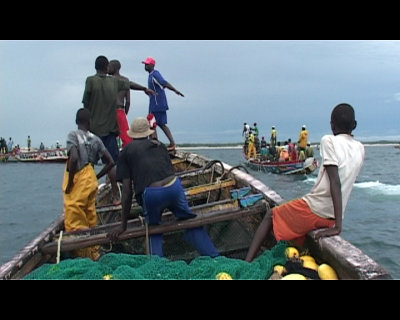 We can already see some results of that questioning in the film itself in the form of increased access of women to education and greater transparency about their social role.
We can already see some results of that questioning in the film itself in the form of increased access of women to education and greater transparency about their social role.
Another sign that the film showed lines of action: Since early 2011 there is at least one pharmacy, but the hospital is still awaited.
“Kayar”, which intends to tell through the village life issues and consequences of globalisation, provides a representative picture of the lives and perspectives of different generations literally “caught in the net”.
At the same time, this documentary shows and proposes "local" actions that have great potential to reverse these problems adding value to the lives of the villagers and creating opportunities for local (sustainable) development.
This is the third documentary film by Thomas Grand. By chosing the music of Seckou Keita as sound track, this French - Lebou filmmaker succeeds with creativity and high quality photography to produce a tool of social communication and media for the development of the town of Kayar.
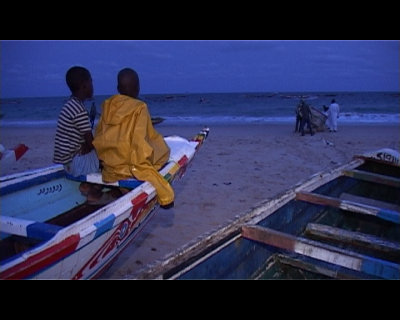 The film is based on an extensive research of about three years.
The film is based on an extensive research of about three years.
This allowed precise targeting of awareness about the challenges and preparing the emergence of new initiatives to address these critical issues experienced in Kayar.
The film "Kayar, a childhood caught in the nets" was selected in the competition at the second film festival "Fishers of the world" in Lorient in March 2010.
The festival selects films about fishermen and fish workers. The jury was composed of equal numbers of film professionals and the fishing industry. Another jury brings together young high school students of maritime schools and from general education.
Click here for the festival site.
For an interview with the film director, read on.
Interview with Thomas Grand, Film Director
MM: What made you produce “Kayar – a childhood caught in the nets”?
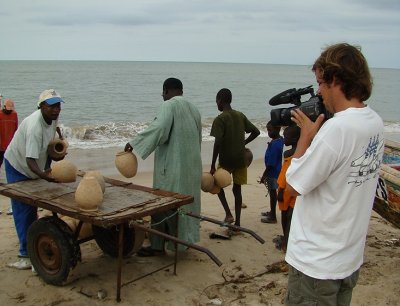 TG: I made a film in 2005, produced by the World Wide Fund for Nature (WWF), on the challenges to implement Marine Protected Areas in Senegal. Through the study of four fishing areas in Senegal (St. Louis, Kayar, Joal-Fadiouth, Kafountine Aben) this film made me discover the world of artisanal fisheries.
TG: I made a film in 2005, produced by the World Wide Fund for Nature (WWF), on the challenges to implement Marine Protected Areas in Senegal. Through the study of four fishing areas in Senegal (St. Louis, Kayar, Joal-Fadiouth, Kafountine Aben) this film made me discover the world of artisanal fisheries.
Kayar really touched me, I met mothers, the elderly, economic, administrative and social agents, the workers of the sea, the children ...
Kayar during the high season is like mine, people are working night and day, but I wondered about the lives of these children, even 6 years or less, whom I saw take to the sea, on board the purse seine pirogues, all those children who are waiting for the landing of the canoes to steal some fish at night or in the full heat of the day, there are also the lives of the girls at home or at the fish processing sites. These questions led me to write this film.
MM: Why did you choose Seckou Keita's music to accompany the images?
TG: I chose this music for its open side, it has no borders; the call of the sea, because the film was shot just after the wave of illegal emigration. These are sequences of traditional music and creations arranged by Senegalese, Egyptian and English musicians.
Seckou Keita is a friend from Ziguinchor, a great musician, singer, kora player and percussionist. During the editing of the film, I told him one day my vision and showed the first footage of the film music. He appreciated and offered all the music of the film. I take this opportunity to greet him warmly and thank him again.
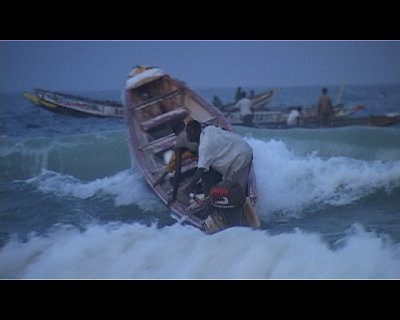 MM: Looking at this intense film, it seems that the entire village of Kayar must have been through a crucial development, however, the film shows that this development is experienced very differently by different groups of people without already lining up the skills of each and the other to achieve a significant improvement in their conditions. What is the current role of those who managed to emigrate?
MM: Looking at this intense film, it seems that the entire village of Kayar must have been through a crucial development, however, the film shows that this development is experienced very differently by different groups of people without already lining up the skills of each and the other to achieve a significant improvement in their conditions. What is the current role of those who managed to emigrate?
TG: The whole of Senegal is in crisis, the crisis touches on social matters, health, education, the economy, political life, many ways of living have collapsed over the past decade. The artisanal fishing sector was at first a refuge area, the sea served as the foster home to many social ills. Faced with this new human and industrial pressure, the marine resources have sharply decreased, and the fishermen and the workers in the marine sector found themselves in serious difficulties.
In 2005-2006, more than half of the fishermen of Kayar crossed or tried to cross the frontiers to Europe, often repeatedly. Among the Senegalese prospective emigrants, fishermen were the most likely, because it is they who were navigating the canoes, travelling free or managing the new business. The fishermen were not afraid to die, they are very familiar with the sea. They had just no hope in Senegal.
Those who managed migration contribute to solving many problems of money and lighten the lives of their families back home, allowing them to make investments (purchases of land, buildings, etc.). This lottery of the initial candidates to go into exile (rejected or accepted ....) had severe psychological consequences for those left behind. The urge to leave remains pervasive among young people today, they see every day that some of them manage to invest, while they toil each day at sea to uncertain and inadequate gain ....
MM: Why Kayar and not another village?
 TG: I wanted to work with this film to create a development platform for NGO's, co-operation agencies and ministries concerned, giving rise to a debate on fundamental development poles of this town, so that the film can attest to the lives of fishing families and make their voices heard.
TG: I wanted to work with this film to create a development platform for NGO's, co-operation agencies and ministries concerned, giving rise to a debate on fundamental development poles of this town, so that the film can attest to the lives of fishing families and make their voices heard.
Through this film, I also wanted to encourage the actors of the film themselves to create a debate about their lives, their culture, their future, their community.
My work is, of course, oriented towards local development, but Kayar also represents the current uncertainties of artisanal fishing regions in Senegal and the development issues of fishing communities at national level.
MM: What were the local reactions in Kayar about the film?
TG: It was unthinkable to broadcast the film without having first projected it at an event in Kayar. So, at the end of the mixing of the film, we organised a big open air screening at night with a giant screen on the fishing pier of Kayar. Almost the entire village was present, as well as representatives of cinematography in Senegal.
The film was well received, I believe, many villagers have addressed prayers for us. The film was widely copied and distributed and all development actors in Kayar have a copy of the film. Over 200 copies of the film were distributed.
I also want to talk about our late father of African documentary, Samba Félix Ndiaye, who had made a film in 1977 "Gëti Tey" on the fishing communities in Kayar and who has advised and accompanied us all along the assembly of the film and at the beginning of the distribution of "Kayar, a childhood caught in the nets." He had sponsored the distribution of the film and has even returned to Kayar 30 years later during the open-air screening. I dedicate this film to him.
MM: If you had the opportunity to make another film about Kayar today, would it be much differenct from the film in 2009?
TG: I would have one wish, I would focus more on emerging social initiatives (such as the creation of a kindergarten ....) and from these initiatives to introduce the film's focus areas, so that it is not a list of demands or complaints but also the testimony of a human and social commitment.
MM: You have won prizes and awards thanks to the film "Kayar – a childhood caught in the nets." Which one was the most meaningful to you?
TG: Thank you, every opportunity to talk about the movie is a victory for us. During these two years now, the invitation to the Festival Fishermen of the World (Lorient, March 2010) was one of the best opportunities to discuss the issues of Kayar. The screening was a real discussion forum for Kayar, because the audience was composed of fisheries professionals, organisation for the protection of the artisanal fisheries, people from Lorient ...
In parallel, we were able to approach the City Council of Lorient, which is historically linked to Kayar, and we could talk about the film with the cooperation department of the municipality. Everything is in their hands now. I want to thank especially all the staff of the Festival Fishermen of the World, Alain le Sann, Danièle Le Sauce and especially Lamine Niasse, without whom all this would never have happened.
 MM: Do you have any new projects in sight?
MM: Do you have any new projects in sight?
TG: Yes, 7 years ago now I set up an audiovisual production unit, Zideoprod, specialising in the production and film making for private and public organisations, NGO's and cooperation agencies in West Africa. We respond to specific requests around development programmes.
Meanwhile, I am currently developing an audiovisual project again in a fishing village and again with child fishers, but more on the aspect of conversion and professional training, through a concrete example, the creation and monitoring of an educational garden (technical agriculture and livestock, orchards), to create new activities for all the young people pushed into the sea. We are currently seeking the direct support of partners to fund this project in plural (educational garden film).
MM: A final question, a film on the other side of the problem - in Europe - is it possible?
TG: Yes, I have often thought about making a movie starting from the fishermen of Kayar leaving to smuggle themselves into Europe, to make them testify, testify to what remained, understand the nature of the links that are transformed by this distance and the interest ... This film might give some answers to the prejudices and questioning of those who remained in Senegal as well as casting some more light on the daily lives of the migrants.
MM: thanks for sharing your views and projects with us.
The interview was conducted by Thomas Zadrozny for Mundus maris. Thomas Grand is based in Senegal and can be contacted at
Thomas Grand
Zideoprod
Production Audiovisuelle, Conseil en Communication
BP 24990 Ouakam-Dakar, Sénégal
Tel: 00 221 77 458 65 13
This email address is being protected from spambots. You need JavaScript enabled to view it.








